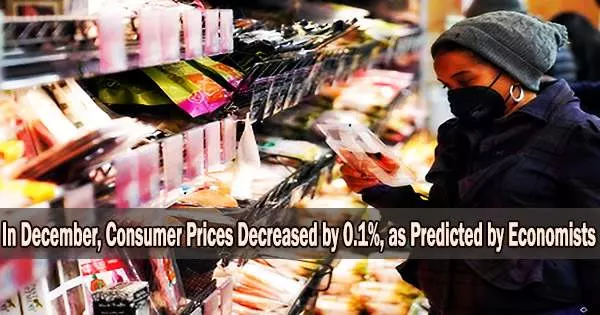According to the Labor Department’s Thursday (January 12, 2023) report, consumer prices posted their largest monthly fall since the early stages of the epidemic in December as inflation modestly declined to end 2022.
According to the Dow Jones estimate, the consumer price index, which calculates the cost of a large variety of goods and services, decreased 0.1% for the month. Due to the fact that a huge portion of the nation was under lockdown to combat Covid, this amounted to the highest month-over-month drop since April 2020.
Even with the reduction, the headline CPI increased 6.5% from a year earlier, underscoring the ongoing strain that rising living costs have had on American households. However, that was the smallest annual increase since October 2021.
Excluding volatile food and energy prices, so-called core CPI rose 0.3%, also meeting expectations. Core was up 5.7% from a year ago, once again in line.
A steep drop in gasoline was responsible for most of the monthly decline. After rising beyond $5 per gallon in mid-2022, gas prices plunged 9.4% for the month and are now down 1.5% from that time last year.
The price of fuel oil fell 16.6% during the month, helping the energy index’s overall fall of 4.5%.
Food prices increased 0.3% in December while shelter also saw another sharp gain up 0.8% for the month and now 7.5% higher from a year ago. Shelter accounts for about one-third of the total CPI index.
Used car costs, another significant initial inflationary force, decreased by 2.5% in the month and are currently down 8.8% year over year. While garment prices increased by 0.5% and transportation services were up 0.2%, medical care services only up 0.1% after falling for two consecutive months.
However, these services are still 14.6% higher than they were a year ago. However, airline fares fell 3.1% for the month though are still up 28.5% from a year ago.
Markets reacted little following the news, with stocks slightly lower at the open and Treasury yields also down across most durations.
Both annual increases remain well above the Federal Reserve’s 2% target, but have been consistently moving lower.
“Inflation is quickly moderating. Obviously, it’s still painfully high, but it’s quickly moving in the right direction,” said Mark Zandi, chief economist at Moody’s Analytics. “I see nothing but good news in the report except for the top-line number: 6.5% is way too high.”
The CPI is the most extensively monitored inflation indicator since it accounts for changes in the price of a gallon of gas, a dozen eggs, airline tickets, and other items.
The Federal Reserve prefers a different gauge that adjusts for changes in consumer behavior. However, the CPI is only one piece of the puzzle that the central bank considers when calculating inflation.
The statistics gave some hints that customer behavior is changing. The December fall was mostly fueled by a drop in petrol prices, which may not be sustained given market dynamics and consumer demand, so that came with a warning.
“We know that we won’t get the same kind of support from gasoline prices. So don’t expect the next report to look as good as this one,” said Simona Mocuta, chief economist at State Street Global Advisors. “But the trend is favorable.”
Markets are watching the Fed’s moves closely as officials battle against inflation that at its peak was the highest in 41 years. Supply chain bottlenecks, the war in Ukraine, and trillions in fiscal and monetary stimulus helped contribute to surging prices that spanned across most areas of the economy.
In order to slow the economy and control inflation, policymakers are assessing how far they may raise interest rates. The Federal Reserve has thus far lifted the benchmark borrowing rate by 4.25 percentage points, making it the highest it has been in 15 years. Before they can take a step back and assess the impact of the tightening of the policy, officials have suggested that the rate is likely to exceed 5%.
Following the CPI report, market pricing pointed toward an increased probability that the Fed would approve a 0.25 percentage point rate increase on Feb. 1. After the central bank approved four straight 0.75 percentage point increases last year before slowing down to a 0.5-point increase in December, it would represent another step backward for the institution.
















